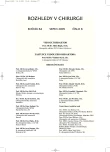Intracranial Meningiomas – Criteria for Selection of the Optimum Therapeutic Modality
Nitrolební meningiomy; kritéria pro výběr optimální léčebné modality
Autoři předkládají vlastní návrh standardního algoritmu diagnostického postupu u nitrolebních meningiomů, který použili v prospektivní nerandomizované longitudinální studii u 30 nemocných během jednoho roku. Postupně byla u každého nemocného určena čtyři kritéria: věk, fyzický stav podle klasifikace ASA, lokalizace meningiomu na MRI (povrchní, lební báze) a invazivita růstu pomocí selektivní DSA (ACI+ACE) a MRI (typ vaskularizace, edémový index a změna intenzity signálu edému za 3,5 hodiny). Tato kritéria umožnila vybrat pro každého nemocného optimální léčebný postup: embolizaci bez následné operace (2 nemocné), observaci (2 nemocní), předoperační embolizaci (5 nemocných) a operaci bez předchozí embolizace (21 nemocných). V práci nejsou hodnoceny výsledky léčby nitrolebních meningiomů, ale je zdůrazněn význam standardizace diagnostického postupu pro indikování jejich optimální léčebné modality.
Klíčová slova:
nitrolební meningiom – ASA – invazivita růstu – embolizace – MRI – selektivní DSA
Authors:
P. Kozler 1; F. Kramář 1; V. Beneš 1; F. Charvát 2
Authors‘ workplace:
Neurochirurgická klinika 1. LF UK a ÚVN, Subkatedra neurochirurgie IPVZ Praha
přednosta plk. prof. MUDr. V. Beneš, DrSc.
1; Radiodiagnostické oddělení ÚVN Praha, přednosta pplk. MUDr. F. Charvát
2
Published in:
Rozhl. Chir., 2005, roč. 84, č. 8, s. 383-391.
Category:
Monothematic special - Original
Overview
The authors present their own proposal for a standard diagnostic procedure algorithm in intracranial meningiomas, which they used in their prospective, non-randomized longitudinal study in a group of 30 subjects within a year. The following four criteria were assessed in each patient: age, physical condition according the ASA classification, location of the meningioma on the MRI (superficial, the scull base) and the growth invasivity using selective DSA (ACI+ACE) and MRI (the vascularization type, the oedema index and the change in the oedema signal intensity in 3.5 hours). The criteria helped to establish the optimum therapeutic procedure for each patient: embolisation without a follow-up surgery (2 subjects), observation (2 subjects), pre-operative embolisation (5 subjects) and surgery without preceeding embolisation (21 subjects). This study did not assess the intracranial meningiomas treatment outcome. It highlights significance of the diagnostic procedures standardization in order to establish their optimum therapeutic modality.
Key words:
intracranial meningioma – ASA – growth invasivity – embolisation – MRI – selective DSA
Labels
Surgery Orthopaedics Trauma surgeryArticle was published in
Perspectives in Surgery

2005 Issue 8
- Metamizole vs. Tramadol in Postoperative Analgesia
- Metamizole at a Glance and in Practice – Effective Non-Opioid Analgesic for All Ages
- Current Insights into the Antispasmodic and Analgesic Effects of Metamizole on the Gastrointestinal Tract
Most read in this issue
- Laparoscopic Surgical Procedures in Children with the Hirschprung’s Disease – Initial Experience
- Analysis of Surgical Procedures on the Vena Saphena Magna in the Czech Republic and an Effect of Detralex during its Stripping
- Modification of Surgical Treatment of Ingrowing Toenail
- Contemporary Trends in the Thoracic Surgery View to the History, Perspective
